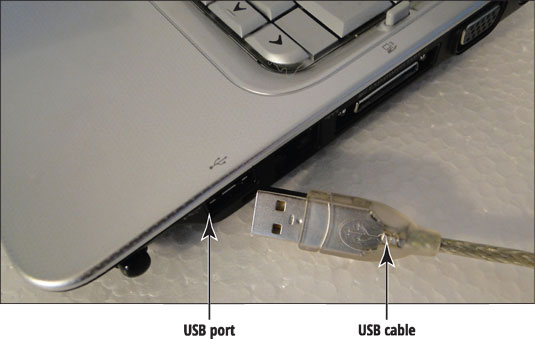Trust USB Plug and Play for Devices in Windows 10
For any hardware additions — which tech folks call peripheral — Windows 10 has a trick up its sleeve. With Plug and Play technology, which automatically identifies additional devices, connecting new devices to your PC can be very easy.
You may find several types of additional devices useful:
The printer allows you to print documents and photos. Your choices include black and white versus color and inkjet versus laser printer. The MFP also functions as a copier, scanner, and fax machine.
Your digital camera takes pictures that you can copy to your computer to enjoy and share with others. See Chapter 10 for information on working with images.
The scanner allows you to make digital images of old photos or documents so that you can view them on the screen.
An external hard drive stores backup copies of your files.
Using an additional or alternative pointing device (a mouse is a pointing device), including a trackball or stylus with your tablet, may be more comfortable to use than what came with your computer. Switching between pointing devices helps you avoid repetitive strain. A wireless mouse takes the hassle out of dealing with a cord. Some people like to add a mouse as an alternative to the touchpad built into their laptop.
A microphone is necessary for voice communication with your computer, through speech recognition, or with your friends over the Internet. Headphone set with microphone may produce the purest sound.
A video camera (or webcam) is essential for Jetsons-style phone video calls.
The majority of these devices connect using USB (Universal Serial Bus) technology. When you connect a device to your computer using a USB cable to the USB port (shown), the device identifies itself to the computer. This identification process is called Plug and Play. Ideally, you plug in your device, and it simply works.

Windows 10 uses the device driver to communicate with an additional device. A driver is really software that tells Windows 10 how to operate a device. When you connect a device, such as a printer, Windows 10 looks for a driver (in this case, a printer driver). This driver may be built into Windows 10, come on a disc that came with the device, or need to be downloaded from the Internet, either automatically by Windows 10 or manually by you.
Every computer has at least two USB ports. Some are in the front, others are in the back of the computer and are hard to reach. If your computer doesn’t have enough ports, you can add more by purchasing a USB hub, which is a small box with two to four USB ports. If it is difficult to access an outlet with the device cable, you can purchase a USB extension cable. Office supply stores may have hubs and cables.
Bluetooth is a wireless technology for adding devices to your computer. If your computer has Bluetooth, you can use Bluetooth in addition to USB to add some devices, especially a microphone or a headset.
